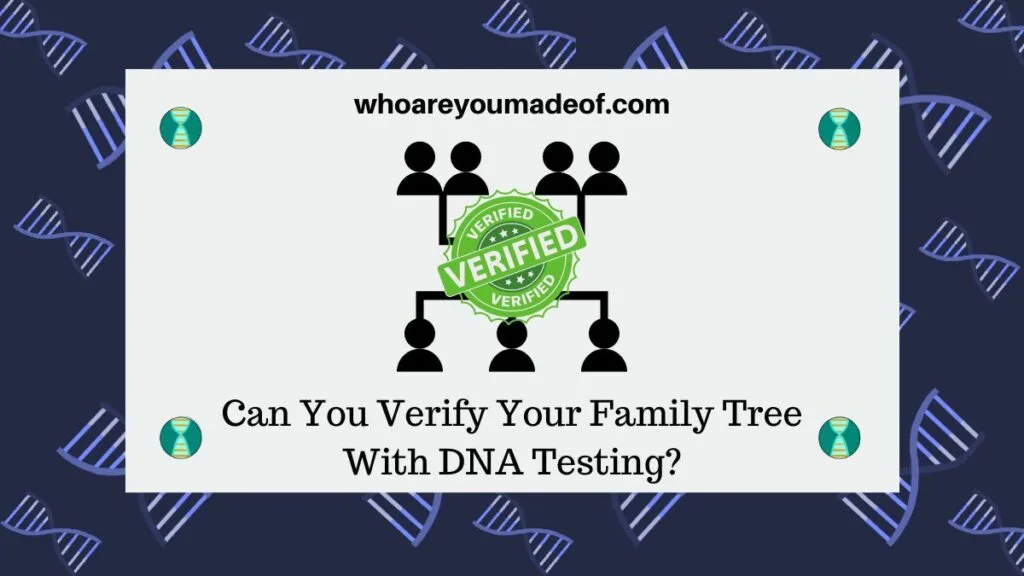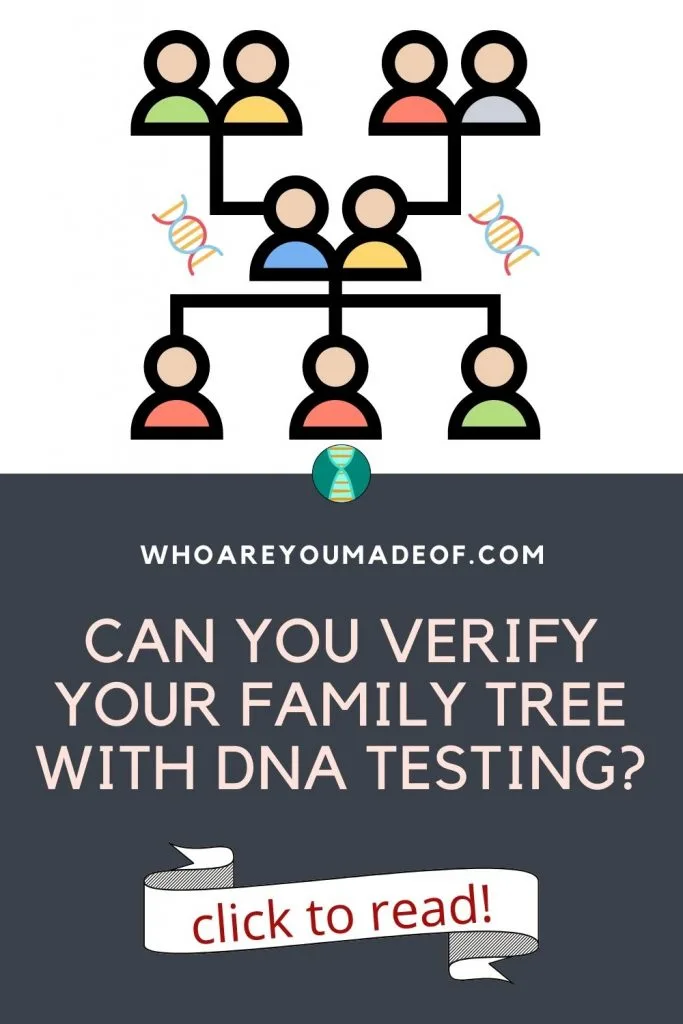Have you ever wondered if there is some way to know whether your family tree is accurate? Perhaps you’ve heard that DNA testing can help you determine whether what you know about your family history is true.
As it turns out, taking a DNA test is an excellent way to verify the accuracy of your family tree.

In this post, I’ll discuss exactly how you can use DNA test results to see whether it matches up with your research, as well as the limitations of using DNA for this purpose.
Are family trees ever wrong?
Yes. There are often many mistakes in family trees, even those researched by professional researchers. The sources of errors and/or mis-attributed paternity, vary.
In fact, most family trees contain many mistakes. Some errors are more consequential than others, but every family tree has at least one mistake.
The types of mistakes that we are most concerned with is listing the wrong ancestor in a line of our tree. When we have mistakes like this, we spend years researching the wrong people, which can be very disappointing.
Family trees often build on the incorrect work of others
Many researchers build upon the work of others. For example, if you have ever used a published compilation of genealogies as a source for your family tree, then you have used the work of a genealogist before you.
These published compilations are a very common “source”, but they are often based upon incorrect information or assumptions. Since we don’t know exactly what information these compilations were based on, we can’t evaluate the accuracy for ourselves.
Not every child is the biological offspring of the people on their birth record
Have you ever heard of the term “non-paternity event“? If you have, then you know that this refers to a male being incorrectly assigned paternity of a child. While this isn’t super common, it does happen.
Depending on the era and the culture, it is estimated to occur in as many as about 2% of births.
Bias can influence family tree accuracy
Finally, people who research family trees are just like you and me. We all have inherent bias, and most of us approach our family tree research with at least some idea as to what we expect to find.
What happens when we find information that doesn’t match with what we thought we knew about our ancestors? What do we do when we find something we don’t like?
Believe it or not, some people choose to ignore or disbelieve information that doesn’t align with the family story. I have even heard of situations where someone makes up a completely false line of a tree just to throw other researchers “off the scent” of a truth that they don’t want discovered.
What do I mean by “verify” a family tree?
When I describe verifying a family tree using DNA, I am referring to the use of DNA in order to eliminate as much doubt as possible in our family trees. DNA can help us “prove”, with limitations (more on this below) that our biological ancestors are who we say they are.
How far back can DNA help you verify?
DNA testing is most useful in verifying our ancestry going back between about 6-8 generations. There are advanced techniques that can help provide evidence for verifying ancestry going back much further, however.
Why can’t DNA verify all of the ancestors in our family tree?
Unfortunately, we don’t inherit DNA from every single ancestor. The further we go back in our tree, the greater the chance is that we didn’t inherit any (or much) DNA from any particular ancestor.
In other words, we will share a lot of DNA with our more recent ancestors, but only small amounts of DNA with some of our more distant ancestors.
Which aspects of DNA results are most helping for verifying a family tree?
The most useful aspect of DNA results are the DNA matches that are provided by the DNA testing companies. Many people take DNA tests for the fun ethnicity estimate and don’t realize that they will even get DNA matches.
Most have no idea of the wealth of information that can be learned from their matches.
But since you are reading this article, you now know that your DNA matches are an excellent source of information (both directly and indirectly) about your ancestry.
How can DNA matches help you verify your tree?
To explain how DNA matches can help you figure out if your family tree has the right people in it, let’s take an example. Let’s call our example DNA tester “Sam”.
Sam believes that his great-grandfather’s parents were Rob and Susan Smith. He’s not 100% sure, since he is only going on information that his grandmother told him.
He has been able to trace the family lines of Rob and Susan Smith, however. He decides to do a DNA test to make sure that he is on the right track with his research.
When he gets his DNA results back, he has lots of second and third cousin DNA matches (estimated relationship to Sam), and he is able to spot a pattern. He has two third cousins who are descended from Bob and Susan Smith, too.
(He checks out my Beginner’s Guide to Shared Centimorgans to make sure that the shared DNA lines up with the genealogical relationship)
For most people, this would serve as enough “proof” (along with, hopefully, some paper documentation that backs up the family story and the DNA) that Sam is, indeed, descended from Rob and Susan Smith.
Advanced techniques to verify a family tree
Believe it or not, Sam can even get more evidence. He could learn about chromosome mapping and paint his DNA matches (no artistic skill required) in order to determine which DNA segments he likely inherited from Rob and Susan.
Same could also ask additional family members to do a DNA test, especially if his parent who is also descended from Rob and Susan is available and willing to test. If they are more closely related, they should share more DNA.
Their results will provide additional data points to help build the case for (or against) the idea that they are truly descended from Rob and Susan Smith.
Ethnicity estimates are only marginally helpful for family tree research
But what about ethnicity estimates, you might wonder. Can they help at all?
Ethnicity estimates are the most popular element of autosomal DNA results, but they are only useful as a general guide when it comes to family tree research.
For example, if an unexpected region shows up in an ethnicity estimate, it can mean that there is recent ancestry from that area in your family tree. This could help you determine where to direct your research, or help you spot clues you might have missed otherwise.
It goes without saying that an ethnicity estimate cannot help verify or disprove the accuracy of a family tree. This is because we only inherit 50% of each of our parent’s DNA, and the same is true for every generation in our tree.
In addition, the 50% of the DNA that a person passes down to their offspring is “randomly selected”.
The end result of this inheritance pattern means that any trace of an ethnicity region can disappear completely in a person’s descendants in only a few generations.
Which DNA test is most helpful for family tree research?
If you are interested in DNA testing for genealogical purposes (i.e. family tree research) and especially want to do a test to verify what have already learned from more traditional methods, you want to take a DNA test from a company that has a focus on genealogy and the largest private database of DNA results in the world.
Ancestry DNA is the best test for verifying a family tree
Which company meets these needs? Ancestry DNA. Ancestry has completed more than 14,000,000 DNA tests (yes, 14 million!).
Since the main purpose of the Ancestry website is family tree research, you’ll find that many of your DNA matches have built family trees. It’s easy to build a family tree on the site, and you can also attach your DNA results to your family tree (this is key!) to get access to more features.
I started my DNA testing journey with Ancestry DNA years ago, and since then more than a dozen of my closest relatives have also tested on the site. This has been a literal goldmine of information for piecing together some of the more mysterious lines of my tree, along with verifying information that I had discovered with the “paper trail” method of genealogy.
In the following post, you can learn about my recommended “ultimate” DNA testing strategy, which begins with Ancestry DNA and helps you get the most from your DNA testing journey:
- Beginner’s Guide to DNA Testing: Ultimate Strategy
Conclusion
I hope that this post helped shed some light on whether DNA testing can help you verify your family tree research, how useful DNA is for this purpose, and which DNA test you should get for family research.
If you have any questions about something that you read in this post, or if you would like to share your own experience with this topic, I would love to hear from you in the discussion below.
Thanks for stopping by today!

